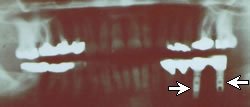
Dental Implants
What are Implants?
Implants are a remarkable procedure. Implants can replace any or all of your teeth. The implant becomes integrated with your bone and acts like a bolt which ultimately supports a new tooth. Some of the advantages of implants for patients who wear dentures are denture stability, increased ability to chew and enjoy their food along with increased patient comfort, appearance, and confidence.
The surgery and restoration of the implant are both performed by Dr. Dunn.
Types of Implants
ROOT FORM IMPLANTS
Implant
Restoration
Root-form implants are the most popular type of implants used in dentistry today. These implants can be either screw-shaped or cylinder-shaped implants. They are used when there is sufficient height and width of bone to accommodate the implant. These implants can be used in all areas of the mouth.
MINI IMPLANTS
These are 1.8 mm diameter implants that can be placed in your lower jaw. It is a one-step procedure that involves minimally invasive surgery and no sutures. The indication for these implants is for patients that have an existing lower denture that they cannot keep stable in their mouth due to severe resorption of their jaw. In about two hours the implants can be placed and your existing lower denture retrofitted to the implants. There is usually minimal discomfort after the procedure that can be controlled with Advil or Tylenol. There is no waiting time. You can eat immediately.
Click for more information on Mini Dental Implants!
Related Implant Procedures
BONE TISSUE BANKS
There are several accredited bone tissue banks in our country. The American Red Cross is one of them. These tissue banks are where we obtain the bone that we use for patients who need grafting procedures.
GUIDED BONE REGENERATION
This procedure is used to generate additional bone at implant sites that do not have enough width or height of bone to accommodate root-form implants.
TOOTH SOCKET PRESERVATION
When a tooth is removed that is going to have an implant placed after the extraction site has sufficiently healed a bone grafting procedure is performed at the time of the extraction to preserve the height and width of the bone. Even with completely normal healing, there is some resorption or loss of bone and gum resulting in less height and width than were present prior to the tooth extraction. If this procedure isn't performed as much as 25% of the width of bone can be lost within one year.
How Are Root Form Dental Implants Placed?
Step One:
The gum is gently folded back and a space is prepared for the implant to be placed.
Step Two:
The dental implant "anchor" is put into place.
Step Three:
A temporary cap is placed on the implant and the gum tissue is repositioned around the implant. The implant is left alone for several months so the bone can attach to the implant and create a secure anchor.
Restorative Phase:
Step One:
After the implant has had a chance to attach to the bone tissue, the temporary cap is removed from the anchor and a post is attached to the anchor.
Step Two:
The implant is now ready for a prosthesis. An impression is taken of the implant and the appropriate prosthesis (crown, bridge, or overdenture) is made.
Step Three:
The prosthesis is then attached to the implant(s).
Considering a Dental Implant?
If you are considering a dental implant, Contact Us for an evaluation appointment. Dr. Dunn or Dr. Castro will perform an evaluation to determine whether you are a good candidate for a dental implant. If you are a good candidate for an implant, Dr. Dunn or Dr. Castro will provide you with further information to help you decide.











